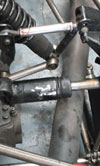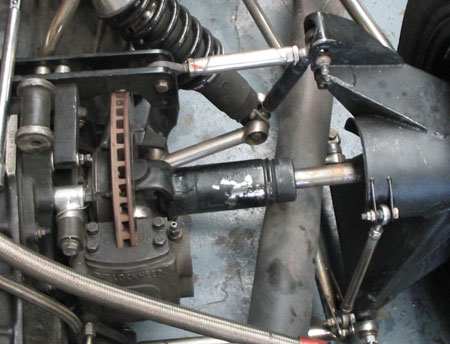Transmitting power
 With the adoption of independent, or de Dion rear suspension by racing car constructors during the 1930s, some means of transmitting the torque from the transmission into the wheel hubs had to be devised that accommodated the vertical motion of the wheel.
With the adoption of independent, or de Dion rear suspension by racing car constructors during the 1930s, some means of transmitting the torque from the transmission into the wheel hubs had to be devised that accommodated the vertical motion of the wheel.
When using a swing axle, this was usually achieved by using a ball-and-socket arrangement integrated into the differential output shafts, while fully independent and de Dion systems required some form of universal joint at each end of the driveshaft.
For many years the Hookes joint, usually made from Hardy Spicer components, was the preferred option, but this could not solve the whole problem in isolation. As the wheels move from full rebound to full bump, they move through an arc of varying radius that seldom coincides with the centre of articulation of the inboard joint. That means the instantaneous distance between this and the corresponding centre on the outboard joint will vary through the range of suspension movement.
On modern cars, which tend to have restricted movement and longer wishbones, this effect is much reduced (although still present) but on older cars with narrower track dimensions and several inches of movement the effect is significant - several tenths of an inch.
In effect, to complete the installation a driveshaft of varying length was required. There were a number of different solutions used, none of them completely satisfactory. The simplest, used on many early Lotus and also on a whole generation of lower formulae cars, was to fit a rubber 'donut' between the inner Hookes joint and the transmission output flange. This could 'soak up' a limited amount of variation and misalignment, but put severe shearing stresses though the rubber, and failure was not uncommon.
A more refined solution was to split the driveshaft into inboard and outboard section, with the inboard sliding axially within the outer on a coarse spline. This could handle the length variation but not always successfully under extreme torque loadings. In this scenario the spline would 'stick', and would in effect become an extra, and rigid, suspension member.
This would momentarily lock up the rear suspension, in much the same way as the spring damper unit would. In turn this would lead to a sudden loss of rear tyre grip and an inevitable 'moment' for the driver. Removing the driving force would then 'unlock' the spline, and movement and grip would be restored.

The elegant answer to this problem was to fit a series of ball bearings between the inner and outer splines so that relative movement between the two no longer depended on sliding friction, but on a rolling bearing. As an engineering solution this was generally successful but it was also heavier, bulkier and - perhaps most significantly - far more expensive, as a number of precision-machined components had been introduced into the assembly. BRM made its own, which were much admired; others modified roadcar units, notably those produced by Mercedes.
A clever solution that avoided the complication and cost of the sliding splines was sometimes used where the amount of axial float would allow it. This was to remove one of the hub bearing shoulders within the rear bearing assembly, and let the hub unit float axially to take up the length variation. A chartered engineer would probably have frowned on this but the racers of the day used it to good effect.
Alternatives to the Hookes joint really only became viable with the move to front-wheel drive roadcars in the 1960s and 1970s, and the investment in constant-velocity joint technology that this brought about, notably from the Lobro company. Before this, it had been necessary to source this type of joint from the Volkswagen parts bin, with variable quality and results, or from Porsche, at a much higher cost. Later still, the tripod joint, also roadcar-derived in many instances and which can generally operate more efficiently at higher angles, tended to be favoured.
Both types, constant velocity and tripod, deal with the length variation issue by allowing the balls or rollers to move along grooves within the housing, their cylindrical form allowing for angular misalignment of the shaft to the housing axis. Ironically the basic principle is almost identical to that used in the simple ball-and-socket type of joint used back in the 1930s.
Fig. 1 - A Hookes type universal joint with a sliding spline driveshaft. This F5000 lola also uses inboard rear disc brakes
Written by Peter Elleray